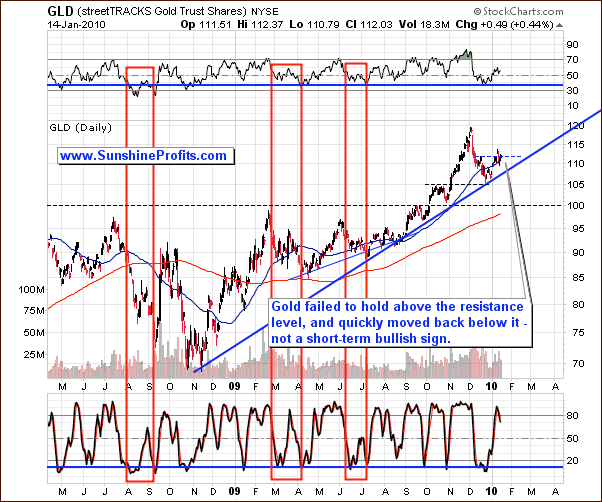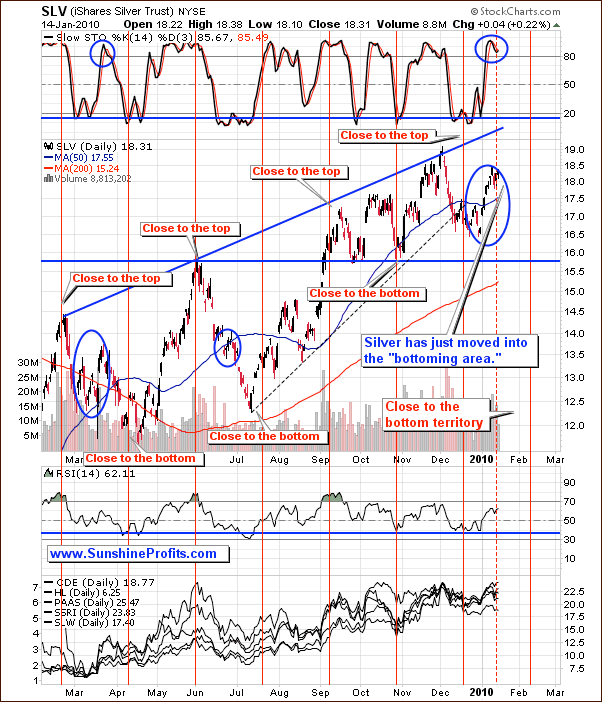Gold and Silver Taking a Breather or Beginning a New Downtrend?
Commodities / Gold and Silver 2010 Jan 15, 2010 - 03:09 PM GMT President Obama’s administration has not been aggressive enough in fixing the root causes that led to the near economic collapse. In a recent speech, Federal Reserve Chairman Ben Bernanke said that it was regulatory failure, not low interest rates that were responsible for the housing bubble and subsequent financial crisis.
President Obama’s administration has not been aggressive enough in fixing the root causes that led to the near economic collapse. In a recent speech, Federal Reserve Chairman Ben Bernanke said that it was regulatory failure, not low interest rates that were responsible for the housing bubble and subsequent financial crisis.
Bernanke denied any Fed culpability for inflating the housing bubble and blamed the "under-regulated" financial sector, which had designed and sold unconventional and exotic mortgage products which later turned out to be toxic.
One may ask why the Fed didn’t do anything to limit the use of these mortgages if they were so dangerous. In addition, the biggest issuers of these mortgages were Fannie Mae and Freddie Mac, both government sponsored entities.
Bernanke conveniently ignores the relationship between the popularity of these mortgages and the low, short-term interest rates that made them possible in the first place. It can be argued that without the ultra-low interest rates provided by the Fed, the vast majority of these problem mortgages would never have been issued.
Regulatory reform to curb the banks’ voracious appetite for risk-taking is moving through Congress at a snail’s pace. While the Treasury has forced banks to raise capital, many still remain thinly capitalized and vulnerable.
Banks have been unwilling to sell bad assets and take a loss. They are stuffed with risky commercial and residential mortgages and consumer debt. While returns for investors last year were zero percent at best, hundreds of thousands of bankers paid themselves hefty bonuses profiting from the taxpayers’ largess. For the bankers its “heads,” they win, “tails,” you lose.
The dose of medicine that the American economy received this past year may have soothed some of the symptoms, but did not treat the root disease. That would mean taking a long-term view, and politicians want short-term results. A major opportunity to make far-reaching changes is being wasted. It was Rahm Emanuel, White House chief of staff, who famously said, “you never want a serious crisis to go to waste.” Although he was criticized for being flippant, he was certainly on to something.
As Nobel Prize winning economist, Paul Krugman, wrote in his New York Times column last week, reform will probably not be able to prevent bad loans or bubbles. But it can go a long way in making sure that when the bubbles burst they don’t take down the entire financial system with them. The 1990’s stock bubble, for example, didn’t rouse a financial crisis because the risk was widely distributed across the economy. Here’s how
Krugman explains it:
By contrast, the risks created by the housing bubble were strongly concentrated in the financial sector. As a result, the collapse of the housing bubble threatened to bring down the nation’s banks. And banks play a special role in the economy. If they can’t function, the wheels of commerce as a whole grind to a halt.
Why did the bankers take on so much risk, Krugman asks. Simple. It was in their self-interest to do so.
By increasing leverage - that is, by making risky investments with borrowed money — banks could increase their short-term profits. And these short-term profits, in turn, were reflected in immense personal bonuses. If the concentration of risk in the banking sector increased the danger of a systemwide financial crisis, well, that wasn’t the bankers’ problem.
It is precisely because of that conflict of interest that we have bank regulation, but rules were relaxed and were not expanded to cover what Krugman calls the “shadow” banking system, such as Lehman Brothers that had began to perform bank-like functions.
Everything was fine as long as housing prices were going up, with finance accounting for more than a third of total U.S. profits as the bubble was inflating. When it collapsed, it was government aid on an unprecedented scale that pulled the financial industry back from the brink of disaster.
Many commentators argue that unless the Obama administration changes the rules, the incentives for bankers to continue doing business as usual will still be there. Like we said, it’s “heads” they win, “tails” we lose.
Krugman argues that banks must be transparent on how much risk they are taking. And finally, reform should limit the financial industry’s compensation practices.
The American public is justifiably fed up and it will be that much harder to get Congress to approve another bailout if another bank crisis unfolds. Regardless of what Bernanke says, as long as interest rates continue to hover at zero, the risk of other financial bubbles forming around the world remains.
If you have confidence in the policies of President Obama, Bernanke, Congress, and the various central banks around the world, then you can rest easy that the world’ s economic future is in good hands. If, on the other hand, you are worried that the politicians and economists don’t know what they are doing and that the only growth industries are government itself and the dollar printing presses, than you should definitely own gold.
Moving on to the technical part of this week's commentary let's begin with the gold market (charts courtesy of http://stockcharts.com.)

Much of what we've written last week regarding the gold market is still up-to-date.
The price of gold moved higher this week, but it was stopped by the resistance level created by the small December top. The history suggests that the gold market often corrects in the form of a zigzag, and the one that we have seen so far is in my opinion too small to say that "that was it".
Please compare the December 2009 downswing to the similar moves in the past that I've marked with red rectangles. Each time correction had two stages, and even the smallest one (June-July 2009) had the biggest upswing within it, than what we've seen in the mid-December 2009. This alone suggests that the current move up is in fact an upswing within a move lower.
The rally in gold was indeed stopped by the closest resistance level and price has been trading sideways since that time. Please note that the performance of the RSI and Stochastic indicators is currently very similar to the way they both behaved in March 2009, after the initial stage of the decline and the following small rally. This suggests that the gold market may need to move lower once again, just like it was the case in the past.
The situation on the silver market confirms points raised above.

Silver often confirms gold's moves (and vice-versa, as they are correlated), and this time the situation isn't any different. Again, points made previously are up-to-date also this week.
The tendency for the silver to correct in more than one stage is even stronger for the white metal than it is for the yellow one, especially after big upswings. This has a lot to do with the fact that silver is generally more volatile than gold, but I don't want to get into details of this mechanism in this particular essay. The point here is that what we've seen up to date is most likely just a first part of the decline. We doubt that the second part would take us much below the recent low, but it appears likely that it will take some time (a week or a few of them) before the final bottom for this decline is put.
Please take a look at the situation in the Stochastic indicator. During past corrections it formed some kind of double-bottom, after which it rallied to/above the 80 level only to correct soon after that. This is where we are today - at the moment Stochastic indicator has just moved above the 80 level. Should the history repeat itself once again, silver may move lower soon.
Based on silver's performance during similar corrections, it currently seem that it may need to move lower - to the $16 level in the SLV ETF - before it moves higher once again. The cyclical tendencies provide additional details as far as timing is concerned, but we will leave this part of the analysis to our Subscribers along with the rest of the full version of this essay (3x bigger than this version with many other relevant charts.)
Summing up, there are no big changes since last week's analysis was posted. The very-long-term price projections are still in place and paint a bullish picture for long-term investors holding gold, silver, and corresponding equities. On the other hand, the short-term outlook remains bearish for the precious metals market.
To make sure that you are notified once the new features (like the newly introduced Free Charts section) are implemented, and get immediate access to my free thoughts on the market, including information not available publicly, I urge you to sign up for my free e-mail list. Sign up today and you'll also get free, 7-day access to the Premium Sections on my website, including valuable tools and charts dedicated to serious PM Investors and Speculators. It's free and you may unsubscribe at any time.
Thank you for reading. Have a great and profitable week!
P. Radomski
Editor
Sunshine Profits
Interested in increasing your profits in the PM sector? Want to know which stocks to buy? Would you like to improve your risk/reward ratio?
Sunshine Profits provides professional support for precious metals Investors and Traders.
Apart from weekly Premium Updates and quick Market Alerts, members of the Sunshine Profits’ Premium Service gain access to Charts, Tools and Key Principles sections. Click the following link to find out how many benefits this means to you. Naturally, you may browse the sample version and easily sing-up for a free trial to see if the Premium Service meets your expectations.
All essays, research and information found above represent analyses and opinions of Mr. Radomski and Sunshine Profits' associates only. As such, it may prove wrong and be a subject to change without notice. Opinions and analyses were based on data available to authors of respective essays at the time of writing. Although the information provided above is based on careful research and sources that are believed to be accurate, Mr. Radomski and his associates do not guarantee the accuracy or thoroughness of the data or information reported. The opinions published above belong to Mr. Radomski or respective associates and are neither an offer nor a recommendation to purchase or sell securities. Mr. Radomski is not a Registered Securities Advisor. Mr. Radomski does not recommend services, products, business or investment in any company mentioned in any of his essays or reports. Materials published above have been prepared for your private use and their sole purpose is to educate readers about various investments.
By reading Mr. Radomski's essays or reports you fully agree that he will not be held responsible or liable for any decisions you make regarding any information provided in these essays or reports. Investing, trading and speculation in any financial markets may involve high risk of loss. We strongly advise that you consult a certified investment advisor and we encourage you to do your own research before making any investment decision. Mr. Radomski, Sunshine Profits' employees and affiliates as well as members of their families may have a short or long position in any securities, including those mentioned in any of the reports or essays, and may make additional purchases and/or sales of those securities without notice.
Przemyslaw Radomski Archive |
© 2005-2022 http://www.MarketOracle.co.uk - The Market Oracle is a FREE Daily Financial Markets Analysis & Forecasting online publication.



